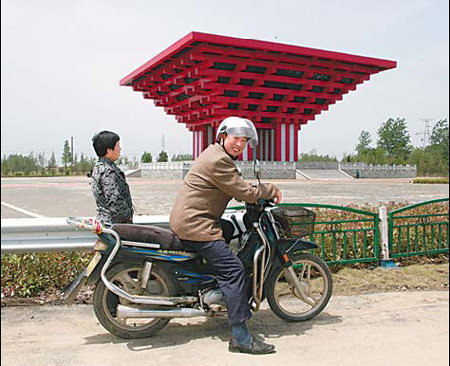'Landmarks' smear image
 |
| A replica of the Expo 2010 China pavilion in Funing county, Jiangsu province, has been drawing attention from motorists passing through the area. |
'Image projects' in impoverished areas of country leave a bad impression of local governments. Hu Yongqi reports from Jiangsu.
When Zhang Haibin first saw the unmistakable outline of the Expo 2010 China pavilion on the horizon, he could not believe his eyes - mainly because he was 454 km away from Shanghai, the host city of the expo.
After remembering where he was - in southern Funing county of Jiangsu province - the 28-year-old Zhang ordered his driver to pull over for a closer look.
"The building is just like the China pavilion at the Shanghai Expo," said the businessman from Anhui province, after getting his assistant to take a picture of him with the large, red structure.
"But I couldn't figure out any practical use for this out here."
At 23 meters tall, Love China - the name of the artwork - is just over one-third the height of the real pavilion in Shanghai. It sits in the center of an 8,000-sq-m paved area, which used to be a tree-lined lawn.
Although officials have spent 3.5 million yuan ($510,000) on the eye-catching project, local residents said the square has nothing else to hold the attention.
When China Daily reporters went there recently, a worker adding finishing touches to the attraction said visitors cannot even go inside the miniature pavilion.
"All you can do is wander around it. There's nothing else to see," he said.
Most people like Zhang passing through Funing stop to marvel at the structure but are usually back in their cars and on their way after a few minutes.
Love China is one of many xingxiang gongcheng, or "image projects" - structures or complexes with no practical use other than to raise a town's profile - that have been built in poor areas across the country this year, analysts said.
Other such "unnecessary" developments include a half-completed 6.1-billion-yuan commercial zone in Qingshuihe in the Inner Mongolia autonomous region; a luxurious office and accommodation complex in impoverished Songxian county, Henan province, and a project to construct 10 golf courses in Lingshui county on the island of Hainan.
All of these locations, including Funing, are nationally recognized as poverty-stricken counties, and experts say the projects are just a few of the examples of how authorities are mismanaging funds given to them by superior governments.
Figures provided by the Funing county planning board shows authorities used 2 million yuan to build the mini China pavilion, which is decorated with lights, and 1.5 million yuan on the square.
"It's a universal phenomenon," said Li Chunting, former deputy director of the Agriculture and Rural Area Committee under the National People's Congress and a current member of the NPC Standing Committee. "All 21 provinces and municipalities I have inspected have built image projects.
"Small towns are constructing unnecessarily huge squares and overly wide roads," he said. "People are being angered by the waste of materials."
Calls for more effective prevention against wasteful spending on image projects have grown in recent years.
The central government implemented new regulations on urban and rural planning in October 2007 stating that authorities should avoid using funds on public projects that could be better spent on improving people's lives. Last year Premier Wen Jiabao urged national auditors to keep a closer eye on public investment to avoid wasteful spending.
However, Qiu Baoxing, vice-minister of housing and urban-rural development, said he believes the regulations on image projects need to be far more strict.
"About one-fifth of China's 660 cities and more than 20,000 towns have too many image projects and make few efforts to build infrastructure," he said, before adding that the public should play a greater role in supervising official agencies.
If governments were required to publicly publish reports on what projects they are working on, residents would have the opportunity to lodge objections with higher levels of authority, said Qiu.
"The problem is," he explained, "in many poor areas, people are not notified before work on these projects starts and don't have the chance to object."
Getting connected
In response to the criticism that has followed construction of the replica pavilion in Funing, officials said they had done nothing illegal and insisted the project was carried out due to public demand.
Li Deping, director of the county information office, admitted the sculpture was mainly intended to boost the image of an area that is "anxious about becoming marginalized".
Yancheng, the city that administers Funing, has the longest coastline in northern Jiangsu, which was last year earmarked for development as part of a national strategy. However, Li explained that without a seaport or good access to an expressway, officials in Funing "felt under unprecedented pressure" to enhance the economy.
"In 2006, we build an entry road onto the expressway so people can get to the coastal highway connecting Highway 204 to Subei Airport," he said. "The sculpture is on the junction with the expressway."
If officials hoped the replica pavilion would act as an impressive landmark and put the county under the spotlight, they were right, but perhaps for the wrong reasons. The criticism targeted at them has largely put the area on the map.
Of the 106 nearby residents polled by China Daily, about 90 percent said the structure was "impractical" and many showed little interest in using the square for any kind of activities.
"The (mini pavilion) might be imposing but it doesn't make any difference to our lives or the local economy," said a man who gave his name as Chen. "That's why we don't like it."
 0
0 







Go to Forum >>0 Comments